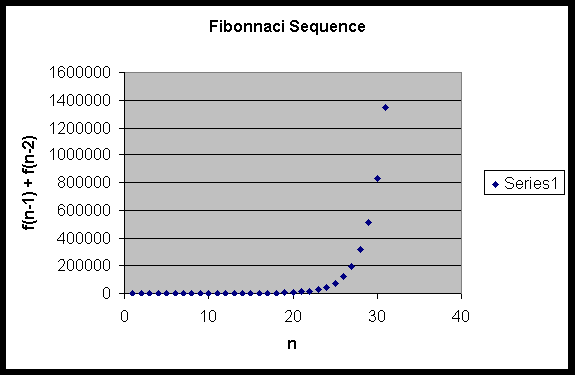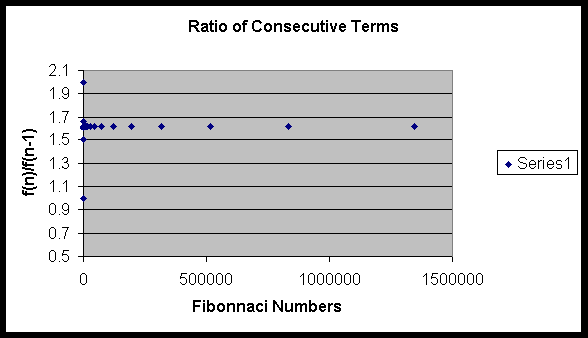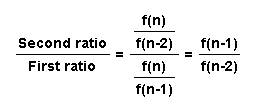
Assignment 12
Fibonnaci and Lucas Sequences
by
Behnaz Rouhani
In this assignment we generate a Fibonnaci sequence
f(n) = f(n-1) + f(n-2)
using f(0) = 1, and f(1) = 1.
First, we will construct the ratio of adjacent terms in the Fibonnaci sequence. Then, observe what happens as n increases. Further, we will explore the ratio of every second, third, fourth, fifth,... terms.
Second, we will explore sequences where f(0) and f(1) are some arbitrary integers other than 1. In addition, we will learn about the Lucas Sequence.
A Fibonnaci Sequence is a sequence of numbers where
f(n) = f(n-1) + f(n-2), and f(0) = 1, and f(1) = 1. We could explore this
sequence using a spreadsheet. Below is a sequence where the first column
represents n and the second column is the sequence produced.
|
|
|
|
|
|
|
|
|
|
|
|
|
|
|
|
|
|
|
|
|
|
|
|
|
|
|
|
|
|
|
|
|
|
|
|
|
|
|
|
|
|
|
|
|
|
|
|
|
|
|
|
|
|
|
|
|
|
|
|
|
|
|
|
|
|
|
|
|
|
|
|
|
|
|
|
|
|
|
|
|
|
|
|
|
|
|
|
|
|
|
|
|
|
|
|
As we can see by the time n reaches thirty the number
in the sequence is over one million. If we graph the above sequence we
would have the following graph:

The graph appears to be exponential, so there must
be a formula for evaluating the value of f(n) without depending on f(n-1)
and f(n-2). In fact a formula does exist and it involves the golden ratio.
The formula is:

Now, we will address the following questions:
1. What is the ratio of each pair of adjacent
terms in the Fibonnaci sequence, and what happens as n increases?
2. What
about the ratio of every second, third, fourth, and fifth terms. Is there
a pattern?
3. Special
investigation.
4. What happens if we change f(0) and f(1)
to some arbitrary integers?
5. What
is a Lucas Sequence?
What is the ratio of each pair of adjacent terms in the Fibonnaci sequence, and what happens as n increases? What about the ratio of every second, third, fourth, and fifth terms. Is there a pattern?
To investigate these questions we will use the spreadsheet. Click here to see the Excel spreadsheet where the first column is n, the second column is the Fibonnaci sequence, the third, fourth, fifth and sixth columns evaluate ratios as denoted below.
In this table,
f(n)/f(n-2) = ratio of adjacent terms
f(n)/f(n-2) = ratio of every second terms
f(n)/f(n-3) = ratio of every third terms
and so on...
It is obvious that as n reaches a certain number, the ratio of adjacent terms reaches the limit of 1.618033989. This number is called the Golden Ratio. This ratio can also be written as

The following graph illustrates how the ratio of
the adjacent terms, f(n)/f(n-1) converge to the golden ratio.

What can we say about the second, third, fourth and fifth ratios? It is interesting to note that:
Second ratio/first ratio = 1.618033989
Third ratio / second ratio = 1.618033989
Fourth ratio / third ratio = 1.618033989
Fifth ratio / fourth ratio = 1.618033989
The reason that the ratio of the ratios turns out to be the golden ratio is because

The above ratio of ratios reduces to the ratio of the terms f (n-1) and f (n-2), which is the golden ratio. This will hold true for all other ratios also.
Special Investigation
Now, what happens if we find the ratios in reverse order? That is, find the ratio of f (n-1)/f (n), f (n-2)/f (n), and so on. Click here to see the Excel spreadsheet for the ratios. In this case the ratio of the adjacent terms reaches the limit of 0.618033989, which is the inverse of the golden ratio. The inverse of the golden ratio could also be written as

If you recall this is another part of the formula for the Fibonnaci sequence.
What can we say about the second, third, fourth, and fifth ratios? Do they reach a limit too? In this case:
First ratio / second ratio = 1.61803399
Second ratio / third ratio = 1.61803399
Third ratio / fourth ratio = 1.61803399
Fourth ratio / fifth ratio = 1.61803399
Can you tell why these ratios turn out to be the golden ratio?
What is a Lucas Sequence?
If we let f (0) = 1, and f (1) = 3, we will get the Lucas sequence. To see the sequence, click here.
As we can see the ratios reach the same limit, which is the golden ratio.
What happens if we change f (0) and f (1) to some arbitrary integers?
Let us explore the Fibonnaci sequence when:
Return to Behnaz Rouhani's Page